
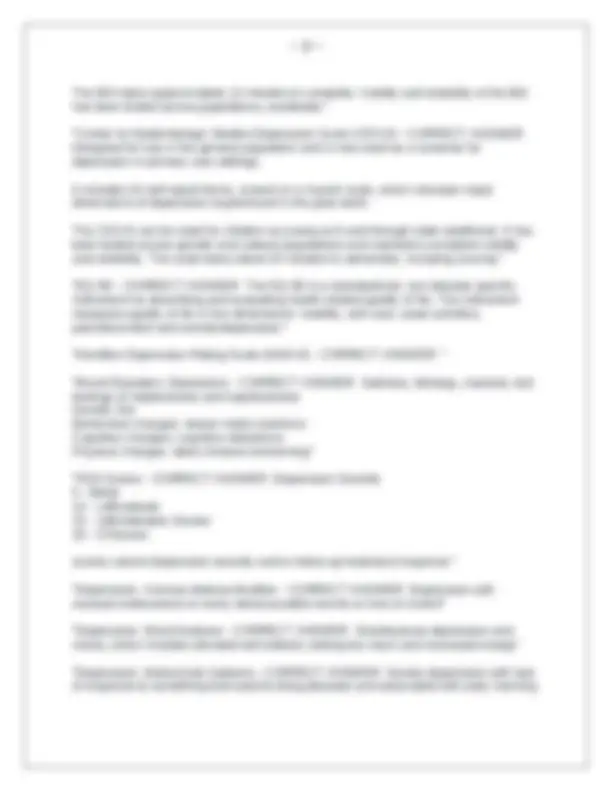
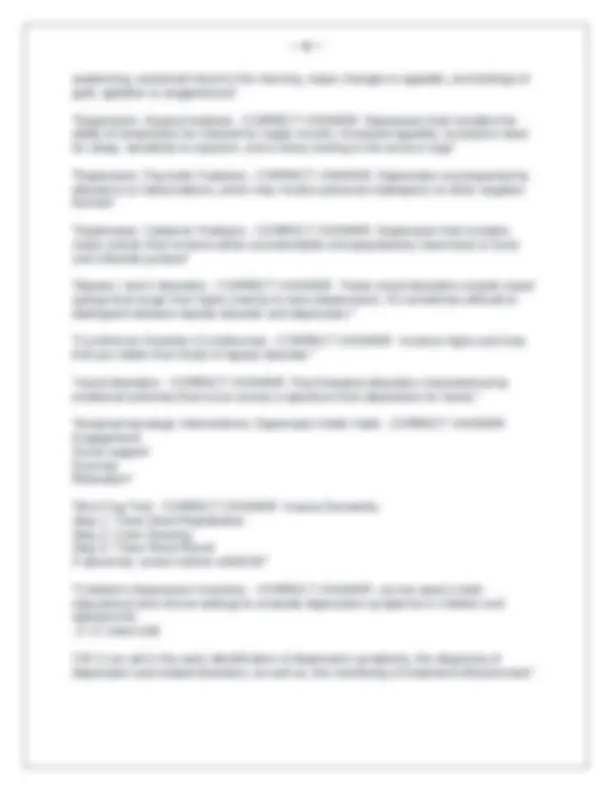
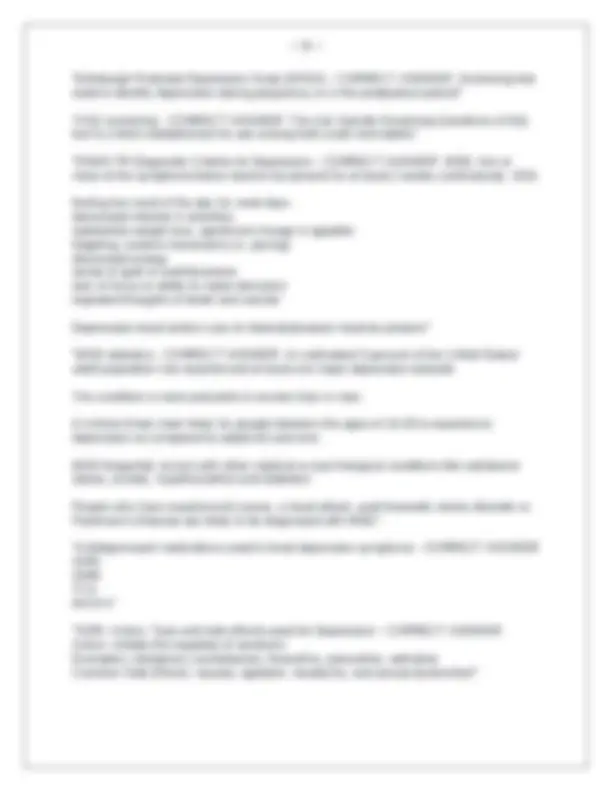
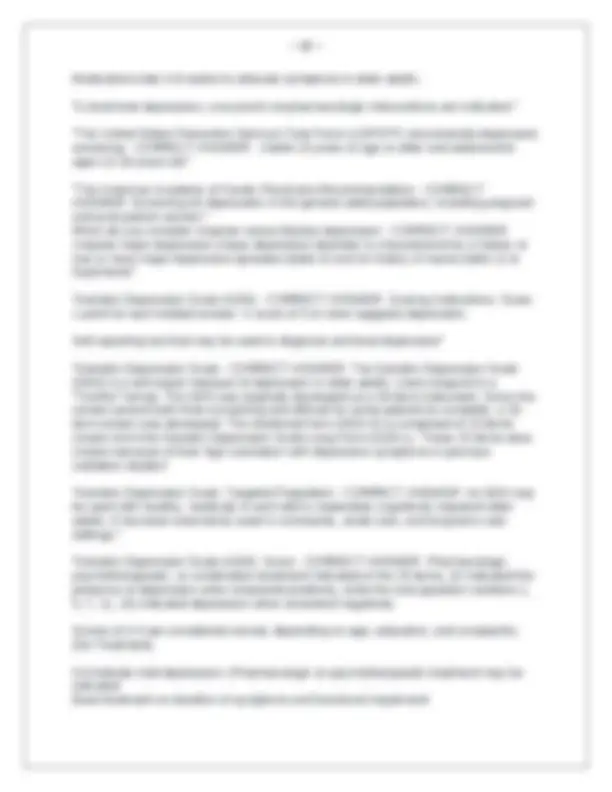
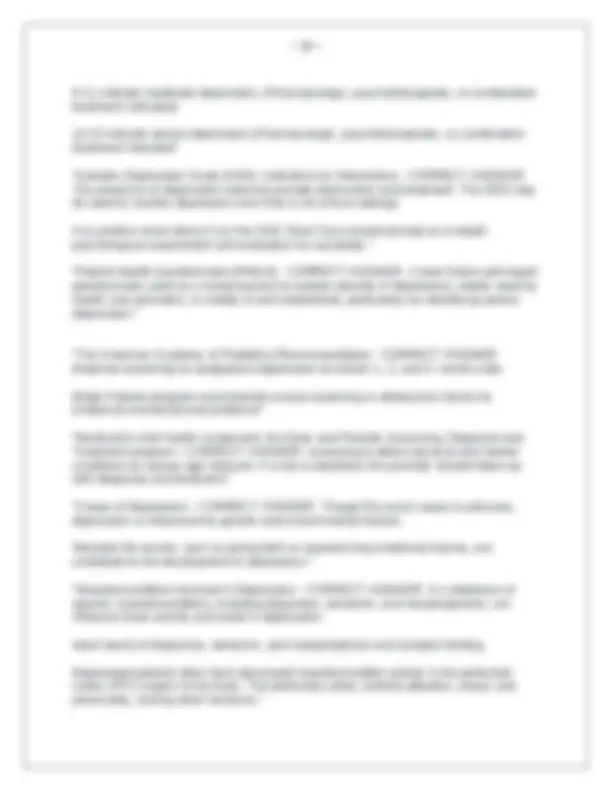
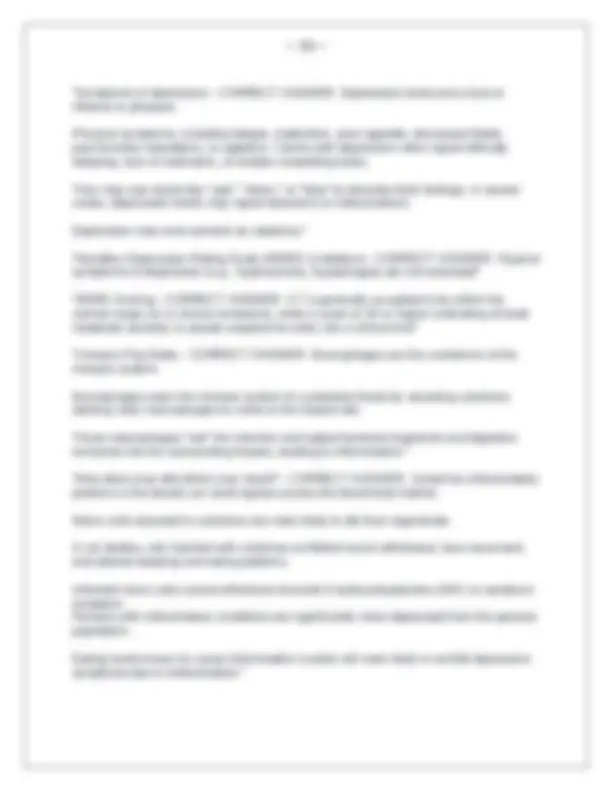


Study with the several resources on Docsity

Earn points by helping other students or get them with a premium plan


Prepare for your exams
Study with the several resources on Docsity

Earn points to download
Earn points by helping other students or get them with a premium plan
Community
Ask the community for help and clear up your study doubts
Discover the best universities in your country according to Docsity users
Free resources
Download our free guides on studying techniques, anxiety management strategies, and thesis advice from Docsity tutors
This study guide offers a detailed overview of various mood disorders, including their diagnostic criteria, symptoms, prevalence, and treatment options. it covers major depressive disorder (mdd), persistent depressive disorder (dysthymia), premenstrual dysphoric disorder (pmdd), and bipolar disorders. the guide also includes information on assessment tools like the beck depression inventory (bdi) and the center for epidemiologic studies depression scale (ces-d), as well as nonpharmacologic interventions. it's a valuable resource for students and professionals in mental health.
Typology: Exams
1 / 11

This page cannot be seen from the preview
Don't miss anything!







"Disruptive Mood Dysregulation Disorder (DMDD) - CORRECT ANSWER This mood disorder in children includes chronic and severe irritability and anger with frequent extreme temper outbursts. This disorder typically develops into depressive disorder or anxiety disorder during the teen years or adulthood." "Persistent Depressive Disorder (Dysthymia) - CORRECT ANSWER Less severe but more chronic form of depression. While it's usually not disabling, persistent depressive disorder can prevent you from functioning normally in your daily routine and from living life to its fullest. Depressed mood, for more days than not, for ≥2 years. Impairment compared with major depressive disorder may be less severe. During the 2 years, the patient has never been without symptoms for more than 2 months at a time." "Premenstrual dysphoric disorder (PMDD) - CORRECT ANSWER Depression symptoms associated with hormone changes that begin a week before and improve within a few days after the onset of your period, and are minimal or gone after completion of your period." "Depression Prevalence in older adults - CORRECT ANSWER Depression is the second leading cause of disability in older adults after cardiovascular disease and impacts around 7% of the geriatric population Biologic factors, including changes in brain structure and neurotransmitters after a cerebrovascular accident (CVA) or with a neurodegenerative disease such as Parkinson's or Alzheimer's disease, may increase the risk of depression. Examine the image below for additional risk factors." "Depression in Older Adults - CORRECT ANSWER Depression is the second leading cause of disability in older adults after cardiovascular disease and impacts around 7% of the geriatric population. Depression often presents as a comorbidity with other physical or cognitive disease processes in older adults and may present differently than in adolescents or younger adults." "Depression risk factors - CORRECT ANSWER Chronic illness Disability/ loss of mobility Change in living situation Role transitions Loss of independence Bereavement Economic hardships"
"Pertinent Information for an Interview: Depression - CORRECT ANSWER socialization, including recent changes or loss ability to complete activities of daily living (ADLs) typical physical activity appetite changes weight loss or gain psychotic symptoms suicidal thoughts or ideations" "Independent risk factor for dementia - CORRECT ANSWER Depression therefore it is important to evaluate cognitive function when depression is suspected. Older clients may have associated memory loss, slowed processing, or impaired executive functioning." "Assessing Depression in Patients with Dementia - CORRECT ANSWER Self-reporting scales, such as the GDS, may be inappropriate. Cornell Scale for Depression in Dementia can be used to screen not diagnose." "The goal of treatment for older adults experiencing depression - CORRECT ANSWER Symptom remission" "First Choice of Treating Depression in Older Adults - CORRECT ANSWER SSRI & SNRI's Escitalopram, citalopram, and sertraline have fewer drug-drug interactions than other medications and are appropriate choices for initial therapy in older adults taking multiple medications." "Clinical pearls for adjusting and discontinuing pharmacotherapy for depression in older adults - CORRECT ANSWER Dose changes: start low, go slow 4-8 weeks for symptom relief reassess if partial improvement, consider adding second drug if no improvement, consider changing to a new drug class maintain pharmacotherapy for at least 1 year after remission to prevent relapse discontinue therapy gradually to reduce withdrawal syndrome (dizziness, anxiety, headache)" "The Beck Depression Inventory (BDI) - CORRECT ANSWER Widely used to screen for depression and to measure behavioral manifestations and severity of depression. The BDI can be used for ages 13 to 80. The inventory contains 21 self-report items which individuals complete using multiple choice response formats.
awakening, worsened mood in the morning, major changes in appetite, and feelings of guilt, agitation or sluggishness" "Depression: Atypical features - CORRECT ANSWER Depression that includes the ability to temporarily be cheered by happy events, increased appetite, excessive need for sleep, sensitivity to rejection, and a heavy feeling in the arms or legs" "Depression: Psychotic Features - CORRECT ANSWER Depression accompanied by delusions or hallucinations, which may involve personal inadequacy or other negative themes" "Depression: Catatonic Features - CORRECT ANSWER Depression that includes motor activity that involves either uncontrollable and purposeless movement or fixed and inflexible posture" "Bipolar I and II disorders - CORRECT ANSWER These mood disorders include mood swings that range from highs (mania) to lows (depression). It's sometimes difficult to distinguish between bipolar disorder and depression." "Cyclothymic Disorder (Cyclothymia) - CORRECT ANSWER Involves highs and lows that are milder than those of bipolar disorder." "mood disorders - CORRECT ANSWER Psychological disorders characterized by emotional extremes that occur across a spectrum from depression to mania." "Nonpharmacologic Interventions: Depression Older Adult - CORRECT ANSWER Engagement Social support Exercise Relaxation" "Mini-Cog Test - CORRECT ANSWER Assess Dementia: Step 1: Three Word Registration. Step 2: Clock Drawing. Step 3: Three Word Recall. If abnormal, screen further w/MMSE" "Children's Depression Inventory - CORRECT ANSWER can be used in both educational and clinical settings to evaluate depressive symptoms in children and adolescents (7-17 years old) CDI 2 can aid in the early identification of depressive symptoms, the diagnosis of depression and related disorders, as well as, the monitoring of treatment effectiveness"
"Edinburgh Postnatal Depression Scale (EPDS) - CORRECT ANSWER Screening test used to identify depression during pregnancy or in the postpartum period" "ASQ screening - CORRECT ANSWER The Ask Suicide-Screening Questions (ASQ) tool is a brief validated tool for use among both youth and adults." "DSM5-TR Diagnostic Criteria for Depression - CORRECT ANSWER MDD, five or more of the symptoms below need to be present for at least 2 weeks continuously. (5/9) feeling low most of the day for most days decreased interest in activities substantial weight loss, significant change in appetite fidgeting, random movement (i.e. pacing) decreased energy sense of guilt or worthlessness lack of focus or ability to make decisions repeated thoughts of death and suicide Depressed mood and/or Loss of interest/pleasure must be present." "MDD statistics - CORRECT ANSWER An estimated 4 percent of the United States' adult population has experienced at least one major depressive episode. The condition is more prevalent in women than in men. It is three times more likely for people between the ages of 18-25 to experience depression as compared to adults 60 and over. MDD frequently occurs with other medical or psychological conditions like substance abuse, anxiety, hypothyroidism and diabetes. People who have experienced cancer, a heart attack, post-traumatic stress disorder or Parkinson's Disease are likely to be diagnosed with MDD." "Antidepressant medications used to treat depressive symptoms - CORRECT ANSWER SSRI SNRI TCS MAOI's" "SSRI: Action, Type and side effects used for Depression - CORRECT ANSWER Action: inhibits the reuptake of serotonin Examples: citalopram, escitalopram, fluoxetine, paroxetine, sertraline Common Side Effects: nausea, agitation, headache, and sexual dysfunction"
"Depression has a documented adverse effect of which medications? - CORRECT ANSWER Corticosteroids Interferon Propranolol Oral contraceptives Levodopa Isotretinoin" "Differentials for Depressed Mood - CORRECT ANSWER Adjustment disorder with depressed mood Substance-/medication- or medical illness-associated and other depressive disorders Bipolar disorder Premenstrual dysphoric disorder (PMDD) Grief/bereavement Dementia Anxiety disorders Alcohol-use disorder Anorexia nervosa Hypothyroidism Medication adverse effects Cushing disease Vitamin B12 deficiency Obstructive sleep apnea (OSA)" "Severe depression - CORRECT ANSWER " "MDD (major depressive disorder) - CORRECT ANSWER 5 symptoms during the same two week period that are a change from previous functioning; depressed mood and/or loss of interest/pleasure must be present; exclude symptoms clearly attributable to another medical condition" "Adjustment disorder with depressed mood - CORRECT ANSWER Adjustment Disorder with Depressed Mood, also called Situational Depression, may sometimes feel nearly as bleak as MDD, but a major difference is that it does not arise out of the blue. Rather, situational depression occurs after there is a specific trauma-divorce, accident, death of loved one, a major life change..." "Depression Education: Older Adult - CORRECT ANSWER Emphasize that medications should be taken as prescribed but that they may not "cure" depression; remission of symptoms is the goal but changes to therapy may need to occur to achieve remission.
Medications take 4-8 weeks to alleviate symptoms in older adults. To best treat depression, concurrent nonpharmacologic interventions are indicated." "The United States Preventive Services Task Force (USPSTF) recommends depression screening - CORRECT ANSWER ·Adults 18 years of age or older and adolescents ages 12-18 years old." "The American Academy of Family Physicians Recommendation - CORRECT ANSWER Screening for depression in the general adult population, including pregnant and post-partum women." When do you consider Unipolar versus Bipolar depression - CORRECT ANSWER Unipolar major depression (major depressive disorder) is characterized by a history of one or more major depressive episodes (table 3) and no history of mania (table 1) or hypomania" "Geriatric Depression Scale (GDS) - CORRECT ANSWER Scoring Instructions. Score 1 point for each bolded answer. A score of 5 or more suggests depression. Self-reporting tool that may be used to diagnose and treat depression" "Geriatric Depression Scale - CORRECT ANSWER The Geriatric Depression Scale (GDS) is a self-report measure of depression in older adults. Users respond in a "Yes/No" format. The GDS was originally developed as a 30-item instrument. Since this version proved both time-consuming and difficult for some patients to complete, a 15- item version was developed. The shortened form (GDS-S) is comprised of 15 items chosen from the Geriatric Depression Scale-Long Form (GDS-L). These 15 items were chosen because of their high correlation with depressive symptoms in previous validation studies" "Geriatric Depression Scale: Targeted Population - CORRECT ANSWER he GDS may be used with healthy, medically ill and mild to moderately cognitively impaired older adults. It has been extensively used in community, acute care, and long-term care settings." "Geriatric Depression Scale (GDS): Score - CORRECT ANSWER Pharmacologic, psychotherapeutic, or combination treatment indicated of the 15 items, 10 indicated the presence of depression when answered positively, while the rest (question numbers 1, 5, 7, 11, 13) indicated depression when answered negatively. Scores of 0-4 are considered normal, depending on age, education, and complaints; (No Treatment) 5-8 indicate mild depression; (Pharmacologic or psychotherapeutic treatment may be indicated Base treatment on duration of symptoms and functional impairment
"Symptoms of depression - CORRECT ANSWER Depressed mood and a loss of interest or pleasure. Physical symptoms, including fatigue, inattention, poor appetite, decreased libido, psychomotor retardation, or agitation. Clients with depression often report difficulty sleeping, lack of motivation, or trouble completing tasks. They may use words like "sad," "down," or "blue" to describe their feelings. In severe cases, depressed clients may report delusions or hallucinations. Depression may even present as catatonia." "Hamilton Depression Rating Scale (HDRS) Limitations - CORRECT ANSWER Atypical symptoms of depression (e.g., hypersomnia, hyperphagia) are not assessed" "HDRS Scoring - CORRECT ANSWER 0-7 is generally accepted to be within the normal range (or in clinical remission), while a score of 20 or higher (indicating at least moderate severity) is usually required for entry into a clinical trial" "Immuno-Psychiatry - CORRECT ANSWER Macrophages are the centurions of the immune system. Macrophages warn the immune system of a potential threat by secreting cytokines alerting more macrophages to come to the injured site. These macrophages "eat" the infection and output bacterial fragments and digestive remnants into the surrounding tissues, leading to inflammation." "How does your diet affect your mood? - CORRECT ANSWER Cytokines (inflammatory proteins in the blood) can send signals across the blood-brain barrier. Nerve cells exposed to cytokines are more likely to die than regenerate. In rat studies, rats injected with cytokines exhibited social withdrawal, less movement, and altered sleeping and eating patterns. Inflamed nerve cells cannot effectively transmit 5-hydroxytryptamine (5HT) or serotonin receptors. Persons with inflammatory conditions are significantly more depressed than the general population. Eating foods known to cause inflammation (carbs) will more likely to exhibit depressive symptoms due to imflammation."
"Medical Diagnoses that Mimic Depressive Disorders - CORRECT ANSWER Hypothyroidism, vitamin D deficiency, hypoglycemia, anemia, vitamin B12 deficiency, chronic fatigue syndrome, and hypotension." "Medications with side effects mimicking depression - CORRECT ANSWER Cannabis, alcohol, clonidine, antidepressants, anticonvulsants, antimigraine agents, corticosteroids, contraceptives, and varenicline (Chantix). Withdrawal from certain substances, such as cocaine or caffeine, can also lead to depressive symptoms."